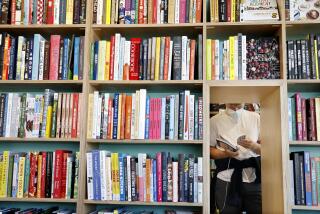The View From the Aisle
- Share via
For the frustrated book fancier with fading memories of the time when the average bookstore offered a solid assortment of good literature and competetent sales personnel, a glimmer of light has begun to appear at the end of this retail black hole: the super-bookstore.
Just as with stationary (Staples), china (Crate and Barrel), home furnishings (Ikea), records (Virgin) and toys (Toys ‘R Us), books--thanks to such dealers as Barnes & Noble and Borders--have again become a featured item in stores designed to overwhelm customers with the visual power of quantity. But the new book emporiums have gone their mega-store brothers one better by creating something akin to a total leisure environment.
Filled with comfy chairs and overstuffed sofas, these new stores not only allow customers to leisurely browse through their many, well-stocked aisles--they actively encourage it. Sales personnel don’t hover about pointing to their watches (as the managers of some newsstands in this city do). And as the stores are equipped with coffee shops, restrooms, special adult-supervised areas for children’s books, and a daily calendar of readings, book-signings, etc., there’s a clear invitation to come on in and spend the whole day. Soon, you may find yourself drawn to such events as the Barnes & Noble Pasadena store’s “Jammyfest”: bedtime stories and cookies so “all you have to do is take the tired tykes home and put them to bed.”
It brings to mind some books (of course). In his collection of late 1860s prose poems, “Paris Spleen,” Charles Baudelaire celebrated the flaneur , or idler, as a vision of the new urban man who “loves to lose himself in a crowd . . . enjoys feverish delights . . . adopts as his own all the occupations, all the joys and all the sorrows that chance offers.” German critic/philosopher Walter Benjamin took up this idea in his 1939 essay “Paris--Capital of the 19th Century,” explaining how the flaneur’s view of the city “went into the construction of the department store, which made use of flanerie itself in order to sell goods.” In other words, the aura of mystery and freedom Baudelaire sensed was something of a mirage; to Benjamin this idler was the ideal consumer.
As if to confirm Benjamin’s perception in advance, Emile Zola’s 1883 novel “The Ladies’ Paradise” offers a vision of a Paris department store driving its impressionable customers to penury with prodigious displays of ribbon, fabric and useless knickknacks. Showing how such tactics create an illusion of consumer choice, Zola does much to explain how today’s mega-stores (which are superseding malls just as Zola’s department store spelled the doom of Paris’ smaller shops) really work.
The number of books offered by the new mega-stores may seem enormous at first, but on closer examination one discovers that particular authors may be represented by only one or two items, and there are many works and subjects completely unaccounted for. Likewise, shoppers may think that they’re wandering about these stores freely, but the grid pattern of book shelving in the Barnes & Noble stores is expressly designed for easy at-a-glance surveillance by its staff. Borders, which breaks with the grid, may seem preferable. But it has surveillance cameras in its ceiling; their images relayed to a central control monitor much like Fritz Lang’s “The Thousand Eyes of Dr. Mabuse.”
Still, for serious book lovers a store could have armed storm troopers guarding the goods, as long as it delivers the goods: basic information relayed from one humanoid form (sales person) to another (customer). On that score the jury is still out for the mega-stores. Some stores have resident experts, others have someone who may know “but he just stepped out to lunch,” others have (some limited) information available on computers. Call it the curse of the service economy and the minimum wage.
Caveat flaneur.
More to Read
Sign up for our Book Club newsletter
Get the latest news, events and more from the Los Angeles Times Book Club, and help us get L.A. reading and talking.
You may occasionally receive promotional content from the Los Angeles Times.







